Dual Modality Collaborative Learning for Cross-Source Remote Sensing Retrieval
Abstract
:1. Introduction
- A new HRRS CS-CBRSIR method (DMCL) is proposed based on the framework of cross-modal learning in this paper. DMCL can learn the discriminative specific and common features from different types of HRRS images, which are beneficial to CS-CBRSIR tasks.
- A common mutual learning module is developed to eliminate modality discrepancy, in which the information corresponding to different sources is forced to exchange reciprocally. Thus, the influence of modality discrepancy can be reduced to the greatest extent.
- The developed dual-space feature fusion module with the modality transform scheme ensures that the HRRS images from different sources can be represented comprehensively. Thus, the distances obtained by those representations can reflect the valid similarity relationships between different RS images.
2. Related Work
2.1. Unified-Source Content-Based Remote Sensing Image Retrieval (US-CBRSIR)
2.2. Cross-Modal Retrieval in Remote Sensing
3. The Proposed Method
3.1. The Overview of the Framework
3.2. Specific Feature Extractor
3.3. Common Feature Learning
3.4. Adaptive Dual-Modality Fusion
3.5. Overall Training and Inference Process
| Algorithm 1 Training Process of DMCL. |
| Input: Dual-source training dataset , the mini-batch size, the maximum iterations T, and the hyper-parameters , , , , and . |
| Output: The trained DMCL model. |
| 1: Initialize the parameters of our DMCL network. |
| 2: for do |
| 3: Select the triplet datasets from training set for MSP and PAN sources randomly. |
| 4: Obtain the specific features ( and ), common features ( and ), cross-source features (, ), and fusion features (, , , and ) by inputting the triplet datasets into DMCL. |
| 5: Compute the loss value by Equation (10). |
| 6: Update the parameters of the DMCL network by the back propagation algorithm. |
| 7: end for |
4. Experiments and Analysis
4.1. Experiment Setup
4.2. Performance of DMCL
4.2.1. Reasonableness of Backbone
4.2.2. Compared with Diverse Methods
4.3. Ablation Study
- Net1: specific feature extractor,
- Net2: specific feature extractor + common feature learning block,
- Net3: specific feature extractor + common feature learning block + adaptive dual-modality fusion block.
4.4. Sensitive Study
5. Conclusions
Author Contributions
Funding
Institutional Review Board Statement
Informed Consent Statement
Data Availability Statement
Conflicts of Interest
References
- Li, Y.; Ma, J.; Zhang, Y. Image retrieval from remote sensing big data: A survey. Inf. Fusion 2021, 67, 94–115. [Google Scholar] [CrossRef]
- Tang, X.; Zhang, H.; Mou, L.; Liu, F.; Zhang, X.; Zhu, X.X.; Jiao, L. An Unsupervised Remote Sensing Change Detection Method Based on Multiscale Graph Convolutional Network and Metric Learning. IEEE Trans. Geosci. Remote Sens. 2021, 60, 5609715. [Google Scholar] [CrossRef]
- Yang, Y.; Tang, X.; Cheung, Y.M.; Zhang, X.; Liu, F.; Ma, J.; Jiao, L. AR 2 Det: An Accurate and Real-Time Rotational One-Stage Ship Detector in Remote Sensing Images. IEEE Trans. Geosci. Remote Sens. 2021, 60, 5605414. [Google Scholar]
- Tang, X.; Meng, F.; Zhang, X.; Cheung, Y.M.; Ma, J.; Liu, F.; Jiao, L. Hyperspectral image classification based on 3-D octave convolution with spatial–spectral attention network. IEEE Trans. Geosci. Remote Sens. 2020, 59, 2430–2447. [Google Scholar] [CrossRef]
- González-Briones, A.; Prieto, J.; De La Prieta, F.; Demazeau, Y.; Corchado, J.M. Virtual agent organizations for user behaviour pattern extraction in energy optimization processes: A new perspective. Neurocomputing 2021, 452, 374–385. [Google Scholar] [CrossRef]
- Decuyper, M.; Chávez, R.O.; Lohbeck, M.; Lastra, J.A.; Tsendbazar, N.; Hackländer, J.; Herold, M.; Vågen, T.G. Continuous monitoring of forest change dynamics with satellite time series. Remote Sens. Environ. 2022, 269, 112829. [Google Scholar] [CrossRef]
- Xu, X.; Zhang, L.; Trovati, M.; Palmieri, F.; Asimakopoulou, E.; Johnny, O.; Bessis, N. PERMS: An efficient rescue route planning system in disasters. Appl. Soft Comput. 2021, 111, 107667. [Google Scholar] [CrossRef]
- Tong, X.Y.; Xia, G.S.; Hu, F.; Zhong, Y.; Datcu, M.; Zhang, L. Exploiting deep features for remote sensing image retrieval: A systematic investigation. IEEE Trans. Big Data 2019, 6, 507–521. [Google Scholar] [CrossRef] [Green Version]
- Jiao, L.; Tang, X.; Hou, B.; Wang, S. SAR images retrieval based on semantic classification and region-based similarity measure for earth observation. IEEE J. Sel. Top. Appl. Earth Obs. Remote Sens. 2015, 8, 3876–3891. [Google Scholar] [CrossRef]
- Tang, X.; Jiao, L.; Emery, W.J. SAR image content retrieval based on fuzzy similarity and relevance feedback. IEEE J. Sel. Top. Appl. Earth Obs. Remote Sens. 2017, 10, 1824–1842. [Google Scholar] [CrossRef]
- Tang, X.; Liu, C.; Ma, J.; Zhang, X.; Jiao, L. Large-Scale Remote Sensing Image Retrieval Based on Semi-Supervised Adversarial Hashing. Remote Sens. 2019, 11, 2055. [Google Scholar] [CrossRef] [Green Version]
- Liu, C.; Ma, J.; Tang, X.; Liu, F.; Zhang, X.; Jiao, L. Deep hash learning for remote sensing image retrieval. IEEE Trans. Geosci. Remote Sens. 2020, 59, 3420–3443. [Google Scholar] [CrossRef]
- Tang, X.; Jiao, L. Fusion similarity-based reranking for SAR image retrieval. IEEE Geosci. Remote Sens. Lett. 2016, 14, 242–246. [Google Scholar] [CrossRef]
- Tang, X.; Zhang, X.; Liu, F.; Jiao, L. Unsupervised deep feature learning for remote sensing image retrieval. Remote Sens. 2018, 10, 1243. [Google Scholar] [CrossRef] [Green Version]
- Tang, X.; Yang, Y.; Ma, J.; Cheung, Y.m.; Liu, C.; Liu, F.; Zhang, X.; Jiao, L. Meta-hashing for Remote Sensing Image Retrieval. IEEE Trans. Geosci. Remote Sens. 2021, 60, 5615419. [Google Scholar] [CrossRef]
- Tang, X.; Jiao, L.; Emery, W.J.; Liu, F.; Zhang, D. Two-stage reranking for remote sensing image retrieval. IEEE Trans. Geosci. Remote Sens. 2017, 55, 5798–5817. [Google Scholar] [CrossRef]
- Chen, L.; Maddox, R.K.; Duan, Z.; Xu, C. Hierarchical cross-modal talking face generation with dynamic pixel-wise loss. In Proceedings of the IEEE/CVF Conference on Computer Vision and Pattern Recognition, Long Beach, CA, USA, 15–20 June 2019; pp. 7832–7841. [Google Scholar]
- Lu, Y.; Wu, Y.; Liu, B.; Zhang, T.; Li, B.; Chu, Q.; Yu, N. Cross-modality person re-identification with shared-specific feature transfer. In Proceedings of the IEEE/CVF Conference on Computer Vision and Pattern Recognition, Seattle, WA, USA, 14–19 June 2020; pp. 13379–13389. [Google Scholar]
- Ye, M.; Lan, X.; Leng, Q.; Shen, J. Cross-modality person re-identification via modality-aware collaborative ensemble learning. IEEE Trans. Image Process. 2020, 29, 9387–9399. [Google Scholar] [CrossRef]
- Yu, E.; Ma, J.; Sun, J.; Chang, X.; Zhang, H.; Hauptmann, A.G. Deep Discrete Cross-Modal Hashing with Multiple Supervision. Neurocomputing 2021, in press. [Google Scholar] [CrossRef]
- Zou, X.; Wu, S.; Bakker, E.M.; Wang, X. Multi-label enhancement based self-supervised deep cross-modal hashing. Neurocomputing 2022, 467, 138–162. [Google Scholar] [CrossRef]
- Kaur, P.; Pannu, H.S.; Malhi, A.K. Comparative analysis on cross-modal information retrieval: A review. Comput. Sci. Rev. 2021, 39, 100336. [Google Scholar] [CrossRef]
- Liu, Y.; Chen, Q.; Albanie, S. Adaptive Cross-Modal Prototypes for Cross-Domain Visual-Language Retrieval. In Proceedings of the IEEE/CVF Conference on Computer Vision and Pattern Recognition, Nashville, TN, USA, 20–25 June 2021; pp. 14954–14964. [Google Scholar]
- Huang, X.; Peng, Y.; Yuan, M. MHTN: Modal-adversarial hybrid transfer network for cross-modal retrieval. IEEE Trans. Cybern. 2018, 50, 1047–1059. [Google Scholar] [CrossRef] [PubMed] [Green Version]
- Li, X.; Yang, J.; Ma, J. Recent developments of content-based image retrieval (CBIR). Neurocomputing 2021, 452, 675–689. [Google Scholar] [CrossRef]
- Bretschneider, T.; Cavet, R.; Kao, O. Retrieval of remotely sensed imagery using spectral information content. In Proceedings of the IEEE International Geoscience and Remote Sensing Symposium, Toronto, ON, Canada, 24–28 June 2002; Volume 4, pp. 2253–2255. [Google Scholar]
- Datcu, M.; Seidel, K.; Walessa, M. Spatial information retrieval from remote-sensing images. I. Information theoretical perspective. IEEE Trans. Geosci. Remote Sens. 1998, 36, 1431–1445. [Google Scholar] [CrossRef]
- Haralick, R.M.; Shanmugam, K.; Dinstein, I.H. Textural features for image classification. IEEE Trans. Syst. Man Cybern. 1973, SMC-3, 610–621. [Google Scholar] [CrossRef] [Green Version]
- Mallat, S.G. A theory for multiresolution signal decomposition: The wavelet representation. In Fundamental Papers in Wavelet Theory; Princeton University Press: Princeton, NJ, USA, 2009; pp. 494–513. [Google Scholar]
- Melissaratos, L.; Micheli-Tzanakou, E. Comments on” Complete discrete 2-D Gabor transforms by neural networks for image analysis and compression. IEEE Trans. Acoust. Speech Signal Process. 1990, 38, 2005. [Google Scholar] [CrossRef]
- Scott, G.J.; Klaric, M.N.; Davis, C.H.; Shyu, C.R. Entropy-balanced bitmap tree for shape-based object retrieval from large-scale satellite imagery databases. IEEE Trans. Geosci. Remote Sens. 2010, 49, 1603–1616. [Google Scholar] [CrossRef]
- Ma, A.; Sethi, I.K. Local shape association based retrieval of infrared satellite images. In Proceedings of the Seventh IEEE International Symposium on Multimedia (ISM’05), Irvine, CA, USA, 12–14 December 2005; pp. 551–557. [Google Scholar]
- Barros, J.E.; French, J.C.; Martin, W.N.; Kelly, P.M. System for indexing multispectral satellite images for efficient content-based retrieval. In Proceedings of the Storage and Retrieval for Image and Video Databases III. International Society for Optics and Photonics, San Diego/La Jolla, CA, USA, 5–10 February 1995; Volume 2420, pp. 228–237. [Google Scholar]
- Shao, Z.; Zhou, W.; Zhang, L.; Hou, J. Improved color texture descriptors for remote sensing image retrieval. J. Appl. Remote Sens. 2014, 8, 083584. [Google Scholar] [CrossRef] [Green Version]
- Yang, J.; Liu, J.; Dai, Q. An improved Bag-of-Words framework for remote sensing image retrieval in large-scale image databases. Int. J. Digit. Earth 2015, 8, 273–292. [Google Scholar] [CrossRef]
- Perronnin, F.; Dance, C. Fisher kernels on visual vocabularies for image categorization. In Proceedings of the 2007 IEEE Conference on Computer Vision and Pattern Recognition, Minneapolis, MN, USA, 18–23 June 2007; pp. 1–8. [Google Scholar]
- Jégou, H.; Douze, M.; Schmid, C.; Pérez, P. Aggregating local descriptors into a compact image representation. In Proceedings of the 2010 IEEE Computer Society Conference on Computer Vision and Pattern Recognition, San Francisco, CA, USA, 13–18 June 2010; pp. 3304–3311. [Google Scholar]
- Yang, Y.; Newsam, S. Geographic image retrieval using local invariant features. IEEE Trans. Geosci. Remote Sens. 2012, 51, 818–832. [Google Scholar] [CrossRef]
- Aptoula, E. Bag of morphological words for content-based geographical retrieval. In Proceedings of the 2014 12th International Workshop on Content-Based Multimedia Indexing (CBMI), Klagenfurt, Austria, 18–20 June 2014; pp. 1–5. [Google Scholar]
- Bosilj, P.; Aptoula, E.; Lefèvre, S.; Kijak, E. Retrieval of remote sensing images with pattern spectra descriptors. ISPRS Int. J. Geo-Inf. 2016, 5, 228. [Google Scholar] [CrossRef] [Green Version]
- Sun, Y.; Ye, Y.; Li, X.; Feng, S.; Zhang, B.; Kang, J.; Dai, K. Unsupervised deep hashing through learning soft pseudo label for remote sensing image retrieval. Knowl.-Based Syst. 2021, 239, 107807. [Google Scholar] [CrossRef]
- LeCun, Y.; Bengio, Y.; Hinton, G. Deep learning. Nature 2015, 521, 436–444. [Google Scholar] [CrossRef] [PubMed]
- Dewi, C.; Chen, R.C.; Yu, H. Weight analysis for various prohibitory sign detection and recognition using deep learning. Multimed. Tools Appl. 2020, 79, 32897–32915. [Google Scholar] [CrossRef]
- Zhou, W.; Newsam, S.; Li, C.; Shao, Z. Learning Low Dimensional Convolutional Neural Networks for High-Resolution Remote Sensing Image Retrieval. Remote Sens. 2016, 9, 489. [Google Scholar] [CrossRef] [Green Version]
- Krizhevsky, A.; Sutskever, I.; Hinton, G.E. Imagenet classification with deep convolutional neural networks. Adv. Neural Inf. Process. Syst. 2012, 25. [Google Scholar] [CrossRef]
- Makhzani, A.; Shlens, J.; Jaitly, N.; Goodfellow, I.; Frey, B. Adversarial autoencoders. arXiv 2015, arXiv:1511.05644. [Google Scholar]
- Yang, M.Y.; Landrieu, L.; Tuia, D.; Toth, C. Muti-modal learning in photogrammetry and remote sensing. ISPRS J. Photogramm. Remote Sens. 2021, 176, 54. [Google Scholar] [CrossRef]
- Mao, G.; Yuan, Y.; Xiaoqiang, L. Deep cross-modal retrieval for remote sensing image and audio. In Proceedings of the 2018 10th IAPR Workshop on Pattern Recognition in Remote Sensing (PRRS), Beijing, China, 19–20 August 2018; pp. 1–7. [Google Scholar]
- Lu, X.; Wang, B.; Zheng, X.; Li, X. Exploring models and data for remote sensing image caption generation. IEEE Trans. Geosci. Remote Sens. 2017, 56, 2183–2195. [Google Scholar] [CrossRef] [Green Version]
- Yuan, Z.; Li, X.; Wang, Q. Exploring Multi-Level Attention and Semantic Relationship for Remote Sensing Image Captioning. IEEE Access 2019, 8, 2608–2620. [Google Scholar] [CrossRef]
- Li, Y.; Zhang, Y.; Huang, X.; Ma, J. Learning source-invariant deep hashing convolutional neural networks for cross-source remote sensing image retrieval. IEEE Trans. Geosci. Remote Sens. 2018, 56, 6521–6536. [Google Scholar] [CrossRef]
- Xiong, W.; Xiong, Z.; Cui, Y.; Lv, Y. A Discriminative Distillation Network for Cross-Source Remote Sensing Image Retrieval. IEEE J. Sel. Top. Appl. Earth Obs. Remote Sens. 2020, 13, 1234–1247. [Google Scholar] [CrossRef]
- Chaudhuri, U.; Banerjee, B.; Bhattacharya, A.; Datcu, M. CMIR-NET: A deep learning based model for cross-modal retrieval in remote sensing. Pattern Recognit. Lett. 2020, 131, 456–462. [Google Scholar] [CrossRef] [Green Version]
- Xiong, W.; Lv, Y.; Zhang, X.; Cui, Y. Learning to Translate for Cross-Source Remote Sensing Image Retrieval. IEEE Trans. Geosci. Remote Sens. 2020, 58, 4860–4874. [Google Scholar] [CrossRef]
- Schroff, F.; Kalenichenko, D.; Philbin, J. Facenet: A unified embedding for face recognition and clustering. In Proceedings of the IEEE Conference on Computer Vision and Pattern Recognition, Boston, MA, USA, 7–12 June 2015; pp. 815–823. [Google Scholar]
- He, K.; Zhang, X.; Ren, S.; Sun, J. Deep residual learning for image recognition. In Proceedings of the IEEE Conference on Computer Vision and Pattern Recognition, Las Vegas, NV, USA, 27–30 June 2016; pp. 770–778. [Google Scholar]
- Anwer, R.M.; Khan, F.S.; Van De Weijer, J.; Molinier, M.; Laaksonen, J. Binary patterns encoded convolutional neural networks for texture recognition and remote sensing scene classification. ISPRS J. Photogramm. Remote Sens. 2018, 138, 74–85. [Google Scholar] [CrossRef] [Green Version]
- Zhang, X.; Wang, G.; Zhu, P.; Zhang, T.; Li, C.; Jiao, L. GRS-Det: An anchor-free rotation ship detector based on Gaussian-mask in remote sensing images. IEEE Trans. Geosci. Remote Sens. 2020, 59, 3518–3531. [Google Scholar] [CrossRef]
- Szegedy, C.; Liu, W.; Jia, Y.; Sermanet, P.; Reed, S.; Anguelov, D.; Erhan, D.; Vanhoucke, V.; Rabinovich, A. Going deeper with convolutions. In Proceedings of the IEEE Conference on Computer Vision and Pattern Recognition, Boston, MA, USA, 7–12 June 2015; pp. 1–9. [Google Scholar]
- Goodfellow, I.; Bengio, Y.; Courville, A. Deep Learning; MIT Press: Cambridge, MA, USA, 2016. [Google Scholar]
- He, X.; Ma, W.Y.; Zhang, H.J. Learning an image manifold for retrieval. In Proceedings of the 12th Annual ACM International Conference on Multimedia, New York, NY, USA, 10–16 October 2004; pp. 17–23. [Google Scholar]
- Tian, Y.; Fan, B.; Wu, F. L2-net: Deep learning of discriminative patch descriptor in euclidean space. In Proceedings of the IEEE Conference on Computer Vision and Pattern Recognition, Honolulu, HI, USA, 21–26 July 2017; pp. 661–669. [Google Scholar]
- Simonyan, K.; Zisserman, A. Very deep convolutional networks for large-scale image recognition. arXiv 2014, arXiv:1409.1556. [Google Scholar]
- Huang, G.; Liu, Z.; Van Der Maaten, L.; Weinberger, K.Q. Densely connected convolutional networks. In Proceedings of the IEEE Conference on Computer Vision and Pattern Recognition, Honolulu, HI, USA, 21–26 July 2017; pp. 4700–4708. [Google Scholar]
- Wu, A.; Zheng, W.S.; Yu, H.X.; Gong, S.; Lai, J. RGB-infrared cross-modality person re-identification. In Proceedings of the IEEE International Conference on Computer Vision, Venice, Italy, 22–29 October 2017; pp. 5380–5389. [Google Scholar]
- Ye, M.; Lan, X.; Li, J.; Yuen, P. Hierarchical discriminative learning for visible thermal person re-identification. In Proceedings of the AAAI Conference on Artificial Intelligence, New Orleans, LA, USA, 2–7 February 2018; Volume 32. [Google Scholar]
- Ye, M.; Wang, Z.; Lan, X.; Yuen, P.C. Visible thermal person re-identification via dual-constrained top-ranking. In Proceedings of the IJCAI, Stockholm, Sweden, 13–19 July 2018; Volume 1, p. 2. [Google Scholar]
- Ma, J.; Shi, D.; Tang, X.; Zhang, X.; Han, X.; Jiao, L. Cross-Source Image Retrieval Based on Ensemble Learning and Knowledge Distillation for Remote Sensing Images. In Proceedings of the 2021 IEEE International Geoscience and Remote Sensing Symposium IGARSS, Brussels, Belgium, 12–16 July 2021; pp. 2803–2806. [Google Scholar]
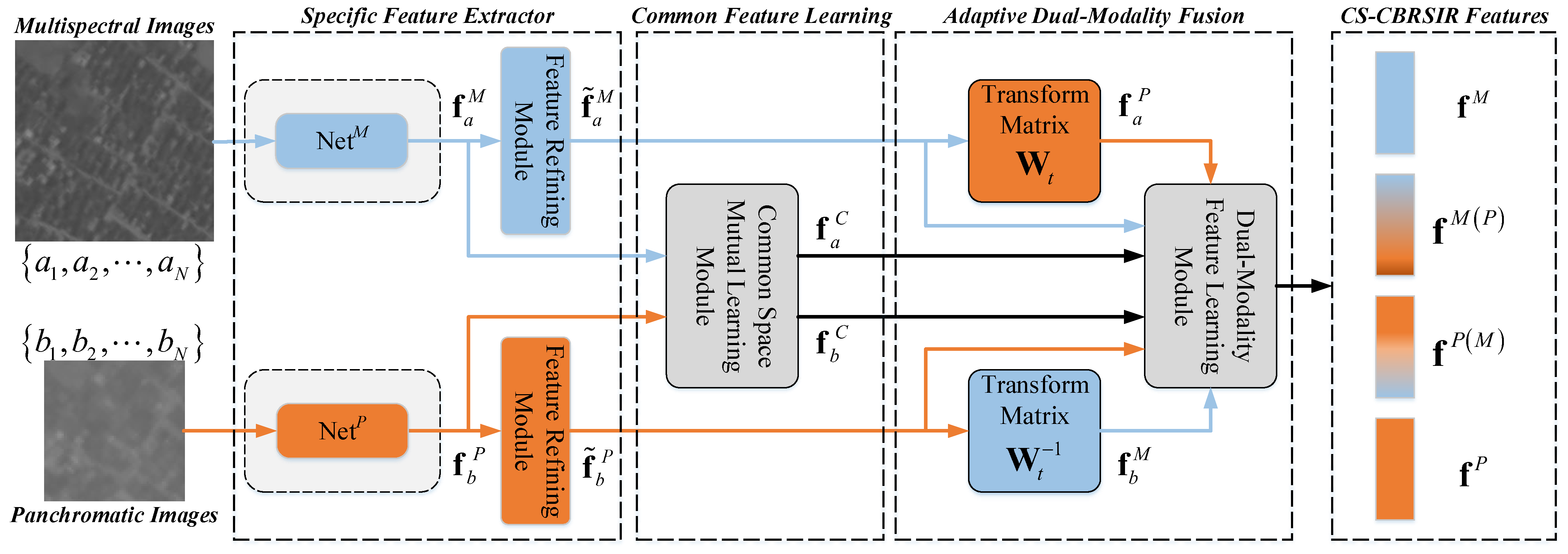
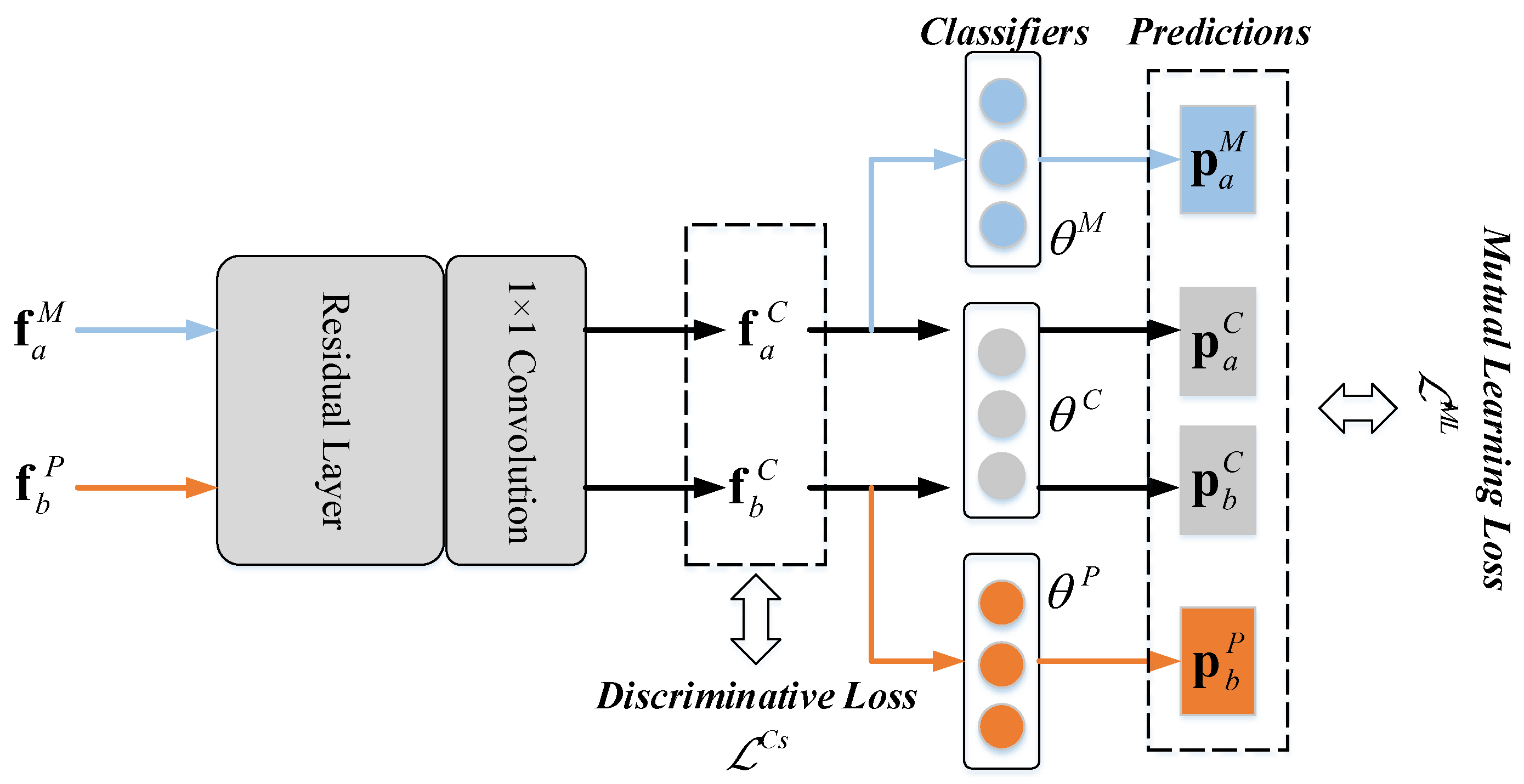
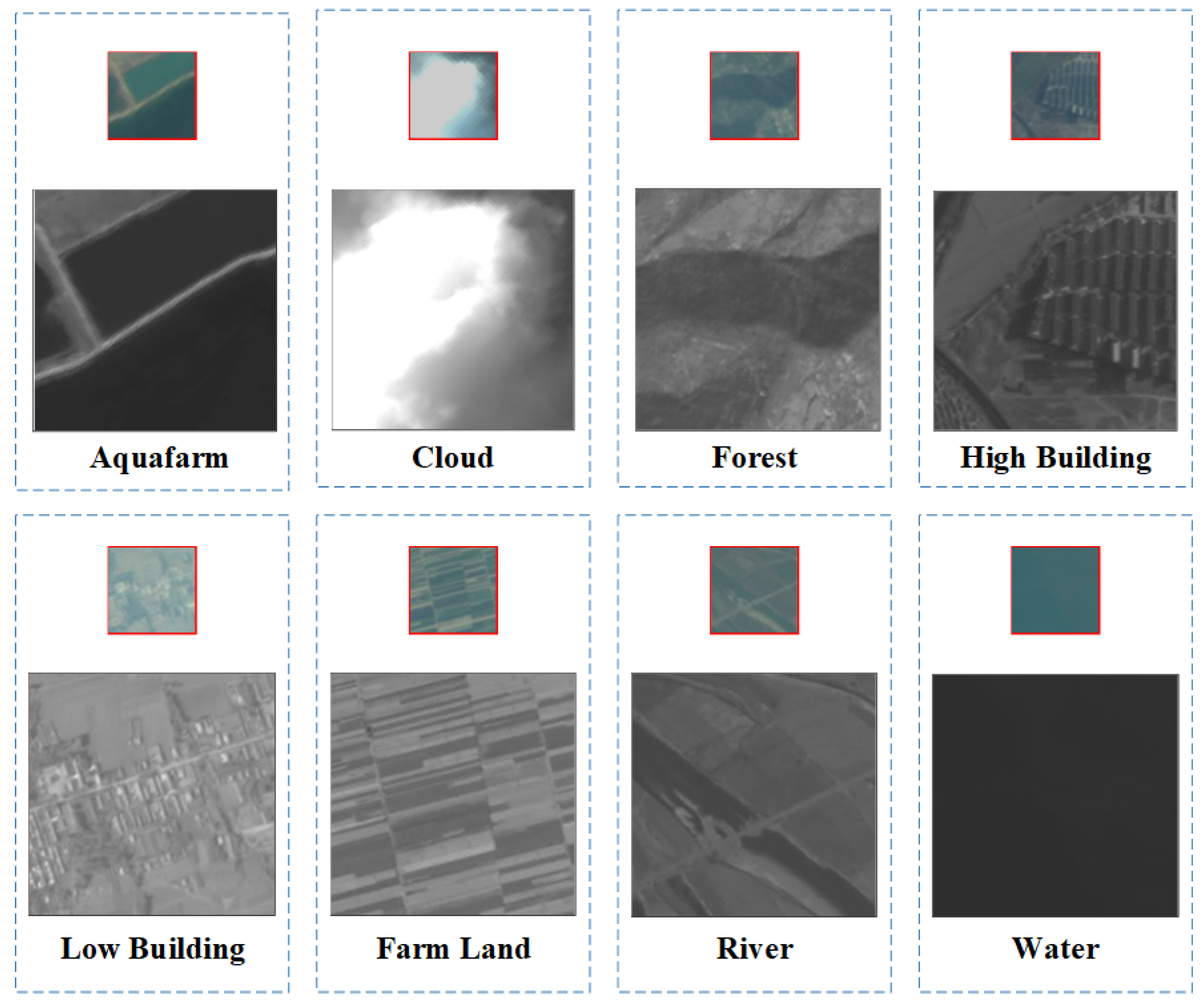
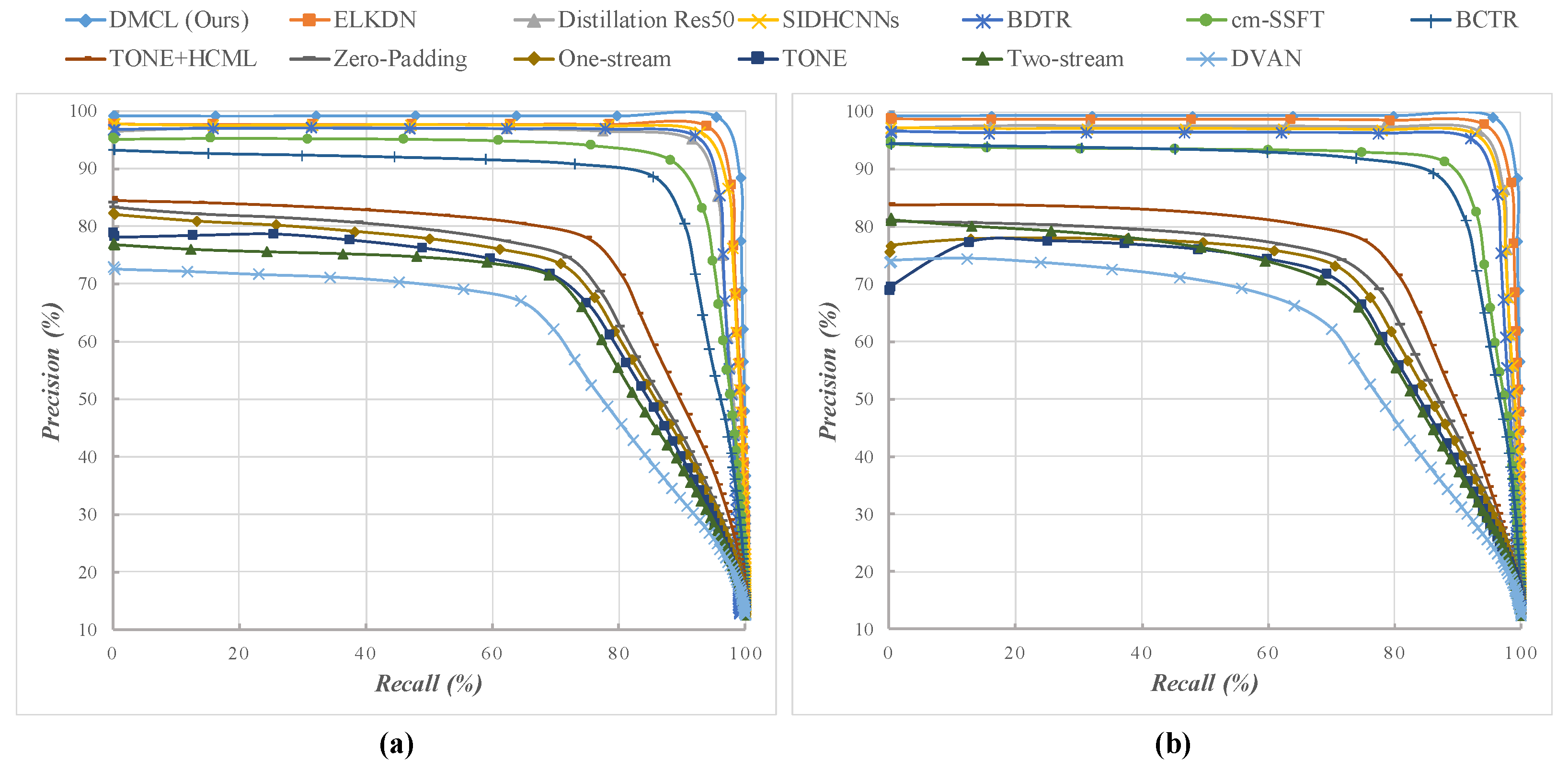
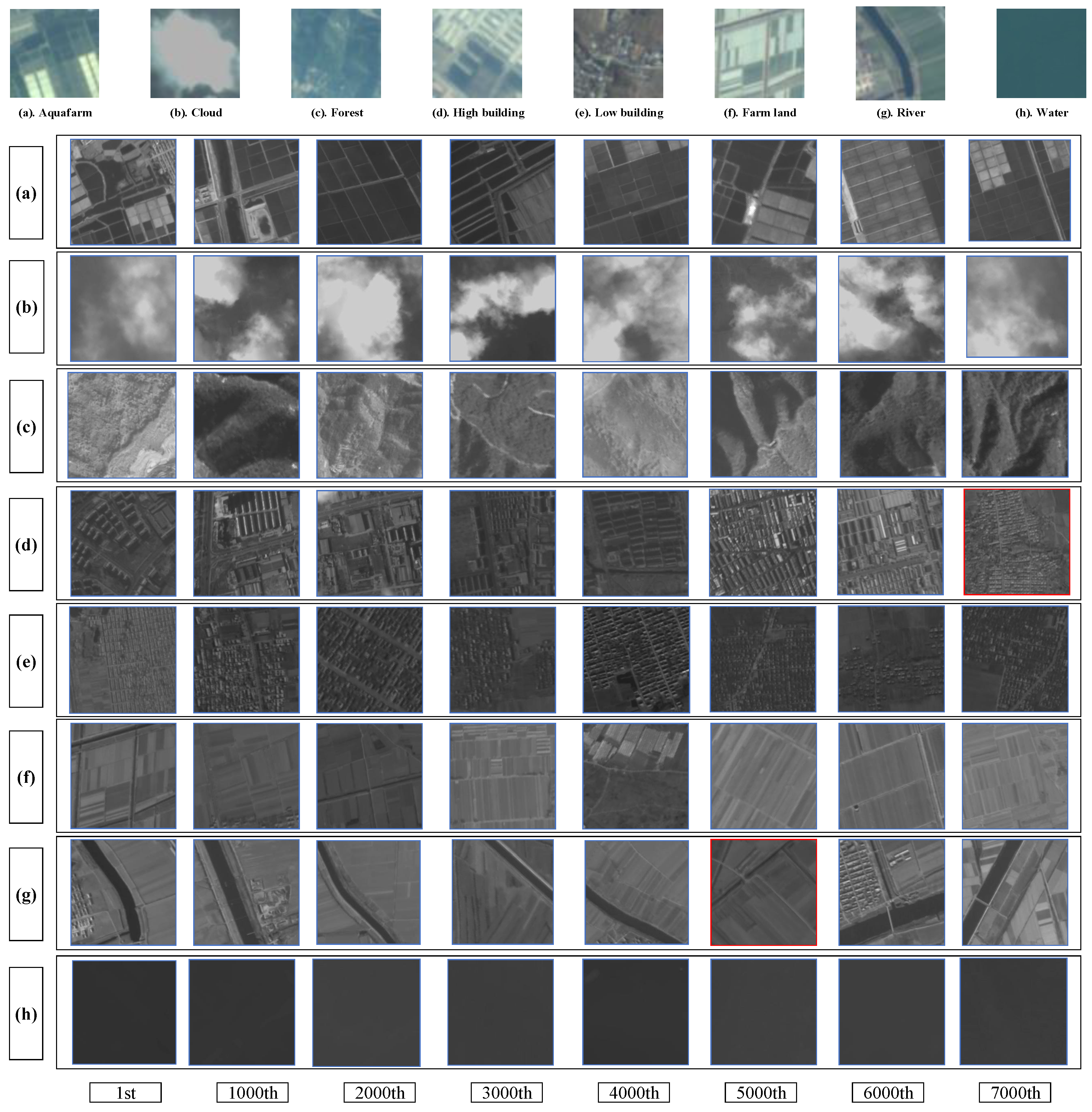
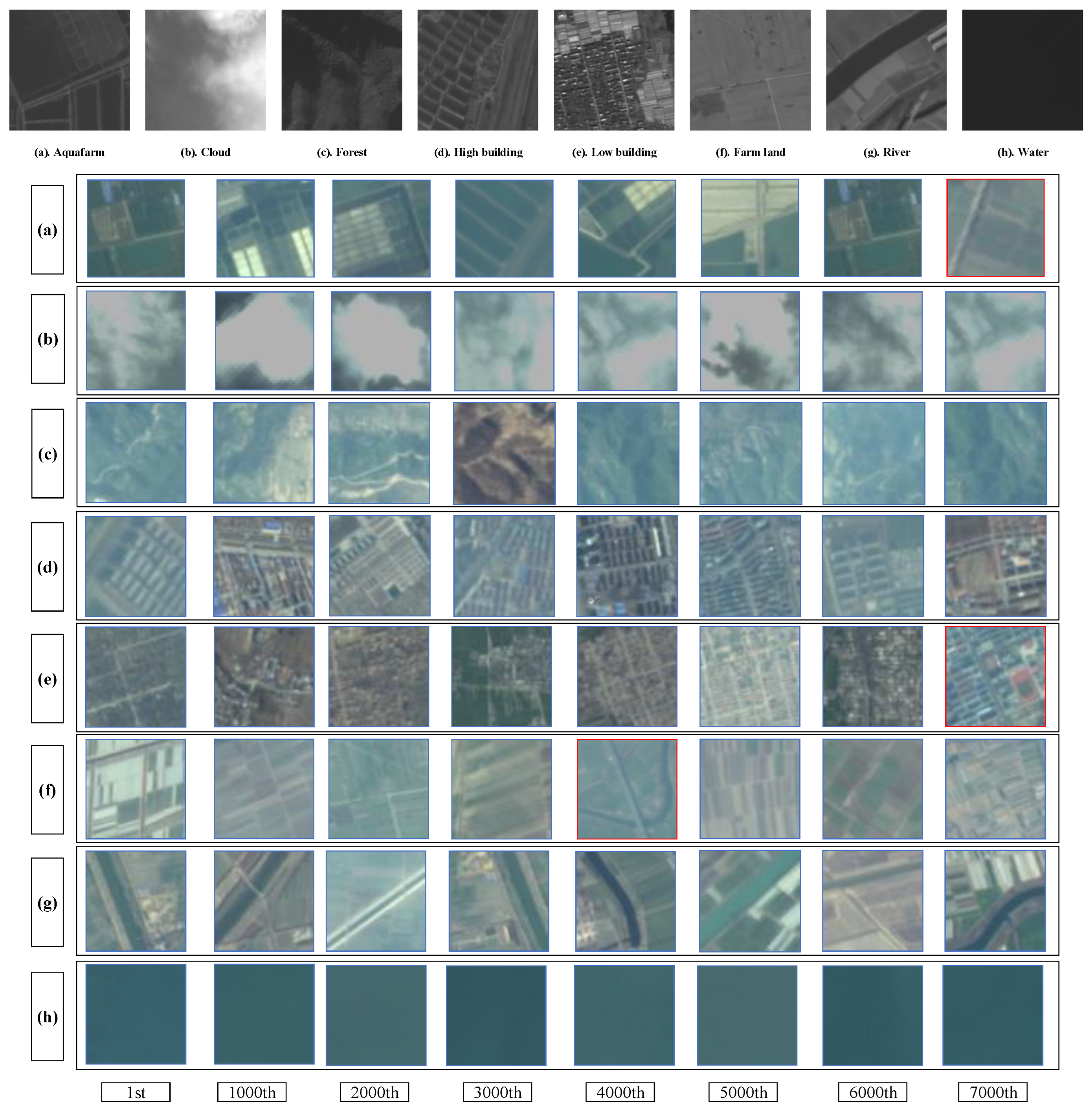
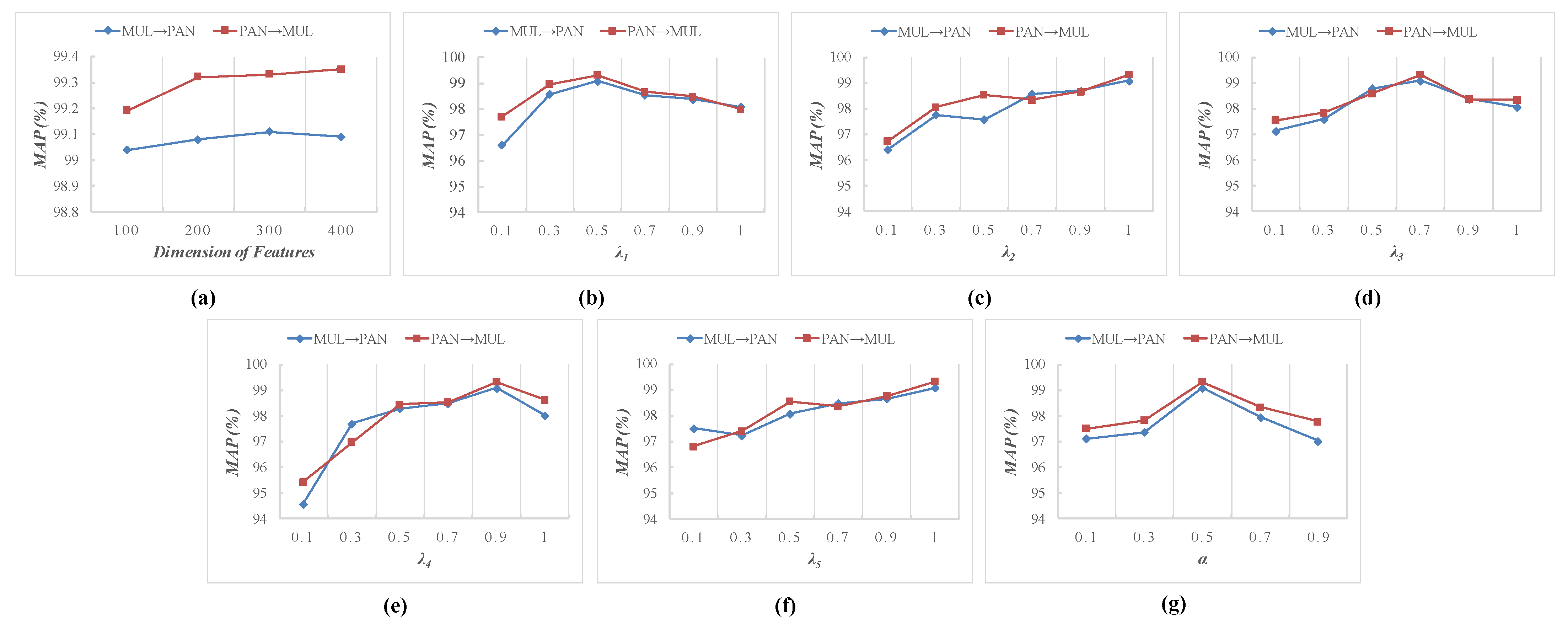
| DMCL-A | DMCL-V | DMCL-D | DMCL | |
|---|---|---|---|---|
| MAP (%) | 96.57 | 97.76 | 98.94 | 99.08 |
| MAP (%) | 97.08 | 98.06 | 98.97 | 99.32 |
| Backbone FLOPs (GB) | 0.71 | 15.62 | 4.28 | 3.53 |
| Backbone Parameters (MB) | 61.1 | 138.36 | 20.01 | 25.56 |
| Methods | ||
|---|---|---|
| DMCL (Ours) | 99.08 | 99.32 |
| ELKDN [68] | 97.91 | 98.45 |
| Distillation-Res50 [52] | 97.94 | 98.09 |
| SIDHCNNs [51] | 97.40 | 97.05 |
| BDTR [67] | 96.09 | 96.28 |
| cm-SSFT [18] | 93.57 | 94.83 |
| BCTR [67] | 93.37 | 92.24 |
| TONE + HCML [66] | 83.06 | 83.27 |
| Zero-padding [65] | 80.77 | 79.55 |
| One-stream [65] | 79.46 | 77.74 |
| TONE [66] | 78.47 | 77.51 |
| Two-stream [65] | 76.63 | 75.84 |
| DVAN [48] | 73.60 | 72.72 |
| Task | Methods | Aquafarm | Cloud | Forest | High Building | Low Building | Farm Land | River | Water |
|---|---|---|---|---|---|---|---|---|---|
| DMCL (Ours) | 99.17 | 100 | 98.01 | 99.41 | 98.69 | 98.07 | 99.28 | 100 | |
| ELKDN [68] | 97.24 | 100 | 97.05 | 96.77 | 98.04 | 96.16 | 98.37 | 99.66 | |
| Distillation-Res50 [52] | 97.34 | 99.93 | 96.99 | 96.81 | 97.99 | 96.10 | 98.61 | 99.80 | |
| SIDHCNNs [51] | 96.73 | 99.97 | 94.71 | 96.63 | 96.22 | 97.16 | 98.03 | 99.74 | |
| BDTR [67] | 93.04 | 92.29 | 95.44 | 95.91 | 96.83 | 97.34 | 97.85 | 100 | |
| cm-SSFT [18] | 88.63 | 99.82 | 93.21 | 90.06 | 92.68 | 88.79 | 95.95 | 99.40 | |
| BCTR [67] | 89.10 | 99.17 | 88.95 | 89.43 | 88.68 | 97.77 | 94.56 | 99.32 | |
| TONE + HCML [66] | 64.13 | 98.26 | 82.61 | 62.61 | 81.88 | 88.01 | 90.53 | 96.45 | |
| Zero-padding [65] | 70.34 | 99.72 | 59.27 | 69.94 | 78.34 | 87.60 | 81.29 | 99.67 | |
| One-stream [65] | 61.70 | 99.19 | 73.97 | 62.42 | 71.09 | 85.71 | 82.86 | 98.74 | |
| TONE [66] | 64.98 | 79.28 | 71.02 | 58.8 | 82.48 | 84.80 | 86.46 | 86.46 | |
| Two-stream [65] | 61.38 | 96.99 | 71.50 | 53.83 | 74.56 | 73.76 | 85.43 | 95.63 | |
| DVAN [48] | 58.31 | 94.55 | 63.84 | 59.44 | 66.41 | 71.20 | 80.78 | 94.47 | |
| DMCL (Ours) | 99.64 | 100 | 97.76 | 99.26 | 99.25 | 99.22 | 99.45 | 99.97 | |
| ELKDN [68] | 98.45 | 100 | 96.41 | 97.97 | 98.01 | 97.86 | 99.05 | 99.87 | |
| Distillation-Res50 [52] | 98.12 | 99.61 | 95.84 | 97.60 | 97.63 | 97.68 | 98.78 | 99.50 | |
| SIDHCNNs [51] | 95.61 | 99.98 | 94.33 | 94.33 | 96.8 | 96.71 | 97.95 | 99.90 | |
| BDTR [67] | 97.15 | 91.35 | 95.29 | 97.56 | 93.62 | 96.92 | 98.62 | 99.74 | |
| cm-SSFT [18] | 92.95 | 99.69 | 87.73 | 93.89 | 91.18 | 96.94 | 96.69 | 99.55 | |
| BCTR [67] | 86.44 | 100 | 84.10 | 86.35 | 94.27 | 92.05 | 94.80 | 99.95 | |
| TONE + HCML [66] | 77.37 | 97.61 | 62.70 | 71.19 | 81.05 | 87.37 | 90.11 | 98.77 | |
| Zero-padding [65] | 68.80 | 99.48 | 65.14 | 70.96 | 71.36 | 78.49 | 85.26 | 96.92 | |
| One-stream [65] | 63.07 | 97.71 | 72.11 | 64.63 | 63.84 | 76.51 | 86.37 | 97.68 | |
| TONE [66] | 56.63 | 99.21 | 71.51 | 69.07 | 74.22 | 86.61 | 77.12 | 85.75 | |
| Two-stream [65] | 62.19 | 95.78 | 68.27 | 54.69 | 71.23 | 75.40 | 84.36 | 94.79 | |
| DVAN [48] | 59.63 | 93.46 | 61.24 | 54.69 | 65.79 | 73.20 | 79.95 | 93.83 |
| Task | Networks | MAP | |||
|---|---|---|---|---|---|
| Net1 | 96.98 | 96.92 | 96.86 | 96.91 | |
| Net2 | 98.61 | 98.63 | 98.59 | 98.63 | |
| Net3 | 99.08 | 99.09 | 99.02 | 99.08 | |
| Net1 | 96.48 | 96.44 | 96.35 | 96.41 | |
| Net2 | 98.76 | 99.25 | 99.13 | 98.75 | |
| Net3 | 99.34 | 99.38 | 99.19 | 99.32 |
Publisher’s Note: MDPI stays neutral with regard to jurisdictional claims in published maps and institutional affiliations. |
© 2022 by the authors. Licensee MDPI, Basel, Switzerland. This article is an open access article distributed under the terms and conditions of the Creative Commons Attribution (CC BY) license (https://creativecommons.org/licenses/by/4.0/).
Share and Cite
Ma, J.; Shi, D.; Tang, X.; Zhang, X.; Jiao, L. Dual Modality Collaborative Learning for Cross-Source Remote Sensing Retrieval. Remote Sens. 2022, 14, 1319. https://doi.org/10.3390/rs14061319
Ma J, Shi D, Tang X, Zhang X, Jiao L. Dual Modality Collaborative Learning for Cross-Source Remote Sensing Retrieval. Remote Sensing. 2022; 14(6):1319. https://doi.org/10.3390/rs14061319
Chicago/Turabian StyleMa, Jingjing, Duanpeng Shi, Xu Tang, Xiangrong Zhang, and Licheng Jiao. 2022. "Dual Modality Collaborative Learning for Cross-Source Remote Sensing Retrieval" Remote Sensing 14, no. 6: 1319. https://doi.org/10.3390/rs14061319
APA StyleMa, J., Shi, D., Tang, X., Zhang, X., & Jiao, L. (2022). Dual Modality Collaborative Learning for Cross-Source Remote Sensing Retrieval. Remote Sensing, 14(6), 1319. https://doi.org/10.3390/rs14061319






